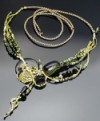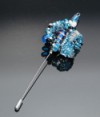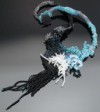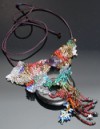NB: this page has been updated, including regularizing the file name, which has changed, so please update your links to the new beadweave index. Thanks!
I have a vivid memory, of when I was perhaps four or five, of picking seed beads off a fraying, loom woven Amerindian belt because the belt came in more colors than any beads I possessed. My mother, to whom the belt belonged, never realized until I told her some years later, why it disintegrated merely for hanging in her closet. My sole source, at that time, for beads of any kind was Frank's Nursery and Crafts, and their selection was pretty limited. Eventually I did loom weave a piece, with eagle feathers, arrows and the like, with my name worked in. I never finished it, and years later I took it apart because I thought it was ugly. (The lesson here is too save your earliest efforts no matter how badly you despise them; someday you'll want to look at ’em again, to see how far you've come, if nothing else.)
So, snarky comments aside, my earliest memories were with seed beads. I started really playing with them again for much the same reason I'd taken up stone and larger glass beads some years before: because I discovered, at long last, decent sources for them. Beadwork, as opposed to making individual beads, comes out of two traditions: metalworking and textile. I tend to hew to the latter, which I find ironic because although I've taken metalworking classes on a sporadic basis since high school I've never had any formal training weaving. Though I love all beads, the difficulty with seed beads is that the individual components disappear into a fabric, as tiles do in a mosaic. You don't see individual tiles.
I've concluded that my real interest lies in playing with interface, or boundary, between individual beads and the overall piece, difficult with such small beads, though I generate some interest in varying sizes of seed beads—the red and yellow peyote stitched donut and the Bumblebee are good examples. Most of the variation in the latter, however, comes from the contrast between the strung and woven elements.
Now that I feel fairly comfortable with some of the more common stitches–peyote, single-needle right-angle weave, brick and square–I've started to work larger beads into the weaving stitches, as well, and I think this is a promising direction. The stickpin is perhaps the first piece that really explores this theme.
Works are ordered more or less chronologically. Update 14aug04: I've added a couple of pieces, and made text links to the all files in this directory (though if you can't see the pictures, why you would bother...)

My first attempt at beadweaving
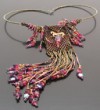
My second attempt at beadweaving. Early 90s? (posted 14aug04)
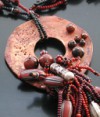
Necklace with copper disk, riveted, woven with fringe. Early 90s? (posted 27dec03)

Variation on a Theme by Gail Frederickson; (closeups posted, 14aug04)

Double pi necklace with 2X configuration

More playing with pis; early 90s? (posted 14aug04)
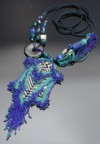
Variation on a Theme by David Chatt
Work by other artists:
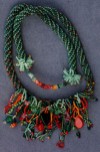
Gail Frederickson's African Helix in Green & Orange N.b.: both image and this work is copyright Gail Frederickson. All rights reserved.
modified: Sun Aug 15 02:15:28 2004; 18oct06
Unless otherwise noted, text, image and objects depicted therein copyright 1996--present sylvus tarn.
Sylvus Tarn
